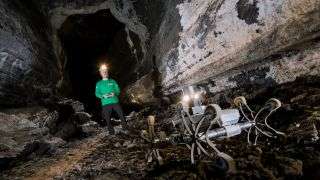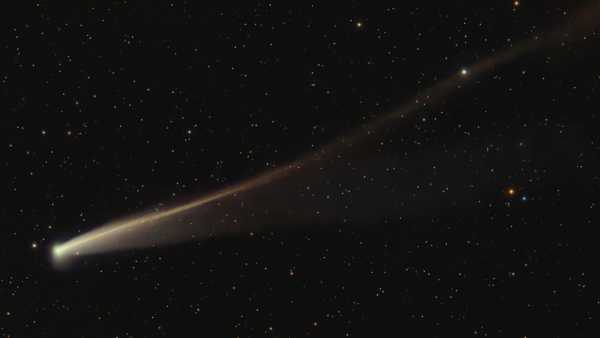
A prototype rover creeps through a lava tube in Spain’s Canary Island of Lanzarote, part of a training campaign to explore settings on Earth that could be similar to those on the moon and Mars.
Mars is pockmarked with absolutely massive lava tubes, with ceilings as high as the Empire State Building, new research shows. And the moon hosts even more gargantuan tubes, with heights that dwarf Dubai’s Burj Khalifa, the world’s tallest building, and “skylights” as big as football fields.
These yawning, subterranean caverns, which are shielded from punishing solar radiation, could be used as sites for future human bases, scientists argue.
A lava tube is a tunnel under a world’s surface, formed by an intense flow of molten rock during a volcanic explosion. On Earth, they’re most easily spotted when they collapse, forming long furrows in the dirt. Partial collapses sometimes form chains of “skylights” that reveal hidden lava tubes that are mostly intact. Researchers have speculated that lava tubes might exist on Mars and the moon since the 1960s, but in recent years Martian and lunar orbiters have beamed home images showing how common these formations likely are, both on the Red Planet and on our moon. Now, researchers argue in a new paper published July 20 in the journal Earth-Science Reviews, it’s time to explore them in earnest.
Here’s why: These lava tubes are truly enormous, and might offer safer habitats than the lunar or Martian surfaces.
“The largest lava tubes on Earth are maximum [about] 40 meters [130 feet] of width and height,” said study co-author Riccardo Pozzobon, a geoscientist at the University of Padova, Italy. “So like a very large motorway tunnel.”
That’s certainly big enough space for some people to fit inside. But on Mars collapsed lava tubes tend to be about 80 times larger than Earth’s, with diameters of 130 to 1,300 feet (40 to 400 m). Lunar lava tubes seem to be still larger, the researchers found, with collapse sites 300 to 700 times the size of Earth’s. Lunar lava tubes likely range from 1,600 to 3,000 feet (500 to 900 m).
A lava tube on the moon, Pozzobon told Live Science, could easily contain a small city within its walls.
The sheer scale of these extraterrestrial lava tubes is likely a result of low Martian and lunar gravity, as well as differences in how volcanoes operated on those bodies compared to Earth.
To assess the size of lunar and Martian lava tubes, the researchers collected 3D laser scans of their counterparts — both collapsed and intact — on Earth. Then they collected all the available satellite images of collapsed lava tubes on Mars and the moon and modeled the size of the intact tubes based on the relationships between collapsed and intact tunnels on Earth.
Lava tubes make appealing human habitats for a number of reasons, including protection from meteors that don’t burn up as easily in the thin Martian and lunar atmospheres, the researchers wrote. They also likely contain useful chemicals, like water ice and volatile chemicals that can be used to make fuel. A thick layer of rock overhead can also, as Live Science previously reported, offer shielding against solar radiation. And skylights would still offer easy access to the surface.
Science-fiction authors like Kim Stanley Robinson have occasionally imagined pressurizing craters or lava tubes and filling them with air. But Pozzobon said that scenario is unlikely, not least because in the moon’s lava tubes, openings can be as wide as a football field.
“Due to their huge size and the possibility of having leaks due to the fracturing of the rocks, I would see pressurizing them very unlikely,” Pozzobon told Live Science. “What is more likely is to establish settlements within these voids, either to host humans or for storing equipment.”
Even stashing a base inside a lava tube presents challenges, however.
“Although a lava tube could provide a shelter to thermal excursion, radiation and micro impacts, it is not easily accessible and the basaltic rocks of its interior can be razor-like sharp and the terrain very uneven,” he said. “So the engineering challenges of placing inflatable habitats within such impressive caves is not trivial and requires very detailed studies.”
Related content:
—The 7 most Mars-like places on Earth
—Voyager to Mars Rover: NASA’s 10 greatest innovations
—The Curiosity rover just took a very emo photo of its rocky Martian prison
Right now, the immediate challenge is gathering more information about the intact lava tubes on the moon and Earth. Right now, researchers can only identify them from satellite images of skylights or collapses. But differentiating a skylight from a simple hole in the ground is tricky. Researchers look for angled images of the holes that reveal the void underneath, he said, or other geological hints of a nearby cave. But nothing beats direct exploration, the researchers wrote.
Models suggest that Martian lava tubes were more likely to have grown to the point of collapse when the planet was volcanically active, and might be harder to find intact. A greater proportion of lunar tubes are probably structurally sound, the researchers wrote. That makes the moon’s lava tubes better candidates for exploration.
It’s important, the researchers wrote, that scientists develop a detailed plan for exploring the tubes. Right now, no rover is autonomous enough or built with the right equipment to go spelunking on the moon or Mars. And before designing and launching a rover to perform that task, satellites equipped with ground-penetrating radar or other remote-sensing technology should build detailed maps of tube formations underground. The process of discovering ideal sites for human sub-lunar or sub-Martian habitation will likely take a long time and involve many intermediate steps, the researchers wrote..
So while Earth may seem like a particularly inhospitable place right now, it’s a little too soon to pack up and relocate to an extraterrestrial lava tube.
Originally published on Live Science.
Sourse: www.livescience.com





